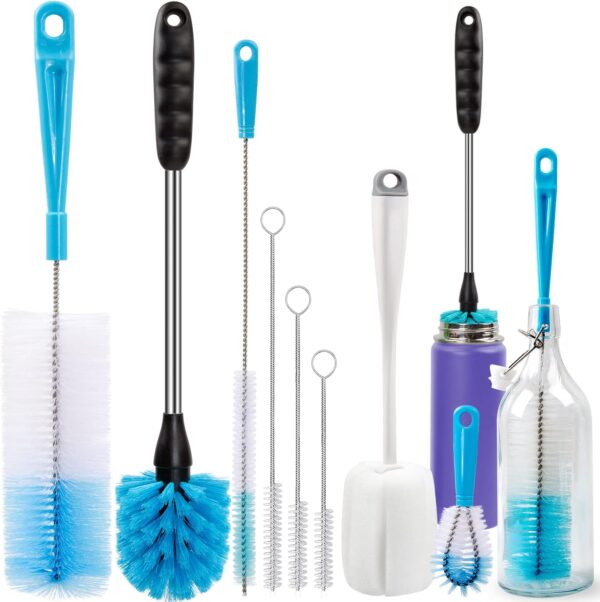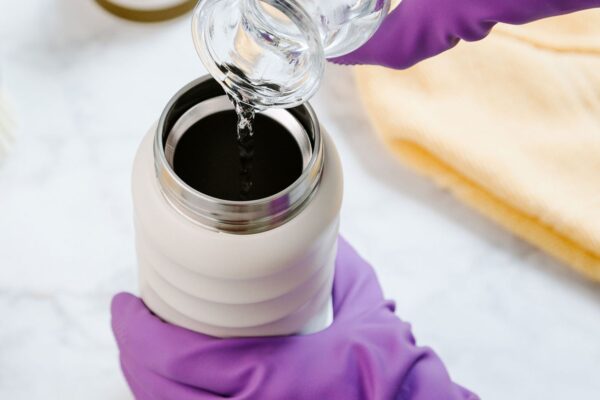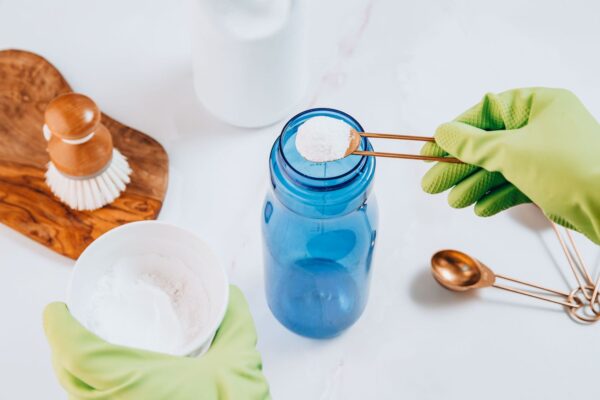Reusable water bottles offer convenience, environmental benefits, and a healthier alternative to single-use plastics. However, without proper cleaning, they can become breeding grounds for mold, germs, and unsightly buildup. By following the steps outlined in this article, you’ll learn how to maintain your water bottles as clean and safe drinking vessels.
The Ultimate Guide: How to Clean a Reusable Water Bottle Like a Pro

Gather the necessary cleaning supplies


Investing in a high-quality bottle brush is essential for a thorough cleaning. Ensure that the brush is long enough to reach all areas inside the bottle. Opt for soft and flexible bristles to avoid scratching your bottles, especially if they are made of stainless steel or glass. Look for a brush with a small tip or tapered end to clean bottle caps and narrow corners. A brush with a hook or hanging hole facilitates convenient storage and faster drying.

How to clean a reusable water bottle based on the water bottle material.
For plastic water bottles, start by rinsing them before each use to prevent bacteria growth. Ensure warm water flows throughout the bottle to remove any buildup or debris. When cleaning, hand wash with a small amount of dish soap. Fill the bottle halfway with warm water, reseal the cap, and vigorously shake to remove residue and stains. Use a mild, fragrance-free dish soap and rinse thoroughly to eliminate any soapy taste. Avoid leaving your soapy water bottle to soak for too long, as it may result in a lingering soap taste. Rinse with warm water immediately after the shaking procedure and allow the bottle to air dry with the cap off.
To tackle stubborn stains in plastic water bottles, make use of a bottle brush. This essential tool reaches areas that soap and water may miss, scrubbing away deposits and bacteria. Rotate the brush for optimal cleaning.
Sanitizing plastic water bottles with boiling water or vinegar is highly effective. Boiling water kills germs and removes persistent residues, while vinegar eliminates odors and stubborn stains. For vinegar sanitization, fill one-fifth of the bottle with vinegar, top it off with warm water, let it sit overnight, then scrub and rinse in the morning. For boiling water, ensure your bottle can withstand high temperatures, pour in the boiling water, let it sit for a few minutes, then empty and air dry for a sparkling clean bottle.
When it comes to cleaning stainless steel water bottle or glass water bottles, handwashing is the preferred method. Dishwashers may subject these materials to extreme temperature changes, potentially damaging them. To hand wash, fill the bottle with warm water (not boiling) and a mild detergent. Rotate the bottle to ensure the solution covers every interior surface, including the cap. Rinse thoroughly and air dry, ideally upside down on a drying rack, to prevent mold growth. Avoid using abrasive cleaners as they can damage the material of the bottle. Instead, opt for soaking with vinegar to eliminate odors. Fill the water bottle with a mixture of one part vinegar to three parts water, let it soak overnight, and enjoy a fresh, odor-free bottle in the morning.
Got questions?
Well, we’ve got answers
It is recommended to clean your water bottle at least once a day, especially with regular use, to prevent bacterial growth and maintain hygiene.
If you discover mold in your water bottle, it’s crucial to address it promptly. Start by rinsing the bottle thoroughly to remove any loose mold spores. Then, create a mixture of one part vinegar to three parts water and fill the bottle. Let it sit overnight to kill the mold. The next day, scrub the bottle using a bottle brush, paying extra attention to the affected areas. Rinse thoroughly and air dry the bottle upside down to prevent mold regrowth.
For most plastic water bottles, it is generally safe to put them in the dishwasher. However, it’s important to check the manufacturer’s instructions or label on the bottle to ensure it is dishwasher safe. Some plastic bottles may not be designed to withstand the high temperatures and harsh detergents used in dishwashers, which can cause them to warp, crack, or deteriorate over time.
On the other hand, stainless steel and glass water bottles are typically not recommended for dishwasher use. The extreme temperature changes and abrasive action of dishwasher cycles can potentially damage these materials, affecting their appearance and performance. It’s best to hand wash stainless steel and glass water bottles with warm water and a mild detergent to ensure their longevity.
Always refer to the specific instructions provided by the manufacturer to determine the dishwasher suitability for your water bottle.
Yes, dish soap is suitable for cleaning water bottles. Choose a mild dish soap and rinse thoroughly to remove any soap residue.
Persistent odors can be eliminated by using baking soda or vinegar. For baking soda, create a paste by mixing it with a small amount of water, apply it to the inside of the bottle, let it sit for 15 minutes, then rinse thoroughly. For vinegar, fill the bottle with a mixture of one part vinegar to three parts water, let it soak overnight, then scrub and rinse in the morning. Both methods effectively neutralize odors.
By following these cleaning guidelines and incorporating them into your routine, you can ensure that your water bottles remain clean, fresh, and safe for use. Remember to prioritize regular cleaning, invest in a bottle brush, and choose cleaning solutions appropriate for the material of your water bottle. With these strategies and a little effort, you’ll enjoy the benefits of a clean and hygienic water bottle every time you take a sip.
Let’s raise your business to the next level, NOW! →
Please get in contact with us if you’re ready to take the next step in your cross-border trading journey. We’re here to help you sort through the intricacies of logistics.

